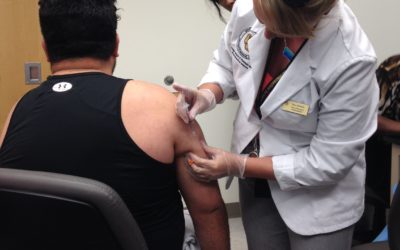Every year the United States is hit with the flu season, and 2020 is no exception. The flu and coronavirus (COVID-19) will be circulating in the coming months, so it is more important than ever to get a flu shot and protect yourself and your loved ones.
The flu is a respiratory disease caused by an influenza virus that infects the nose, throat, or lungs. Symptoms of the flu can range from mild to very serious, including death. The flu is different from a cold, as it generally comes on very suddenly and may cause symptoms such as fever/chills, cough, sore throat, runny or stuffy nose, muscle or body aches, headaches, tiredness. It generally causes illness in the fall and winter, which is why it often is called “flu season”. The centers for disease control (CDC) estimate that last season at least 410,000 people were hospitalized from the flu and less than half of Americans got a flu shot. Unlike with the novel coronavirus, there is a vaccine to protect people from the flu, thankfully. The flu shot reduces the risk of illness from the flu, hospitalizations, and even flu-related death in children. It also helps protect those around you when you get the flu shot because the more people vaccinated against the flu, the less likely the virus is to circulate through the population. The CDC recommends every person over the age of 6 months should get an annual flu vaccine by the end of October, especially those with chronic conditions that put them at increased risk of serious flu complications. When you get a flu shot, it introduces your body to the types of influenza virus in the vaccine and your body will develop antibodies to protect you from the virus if it encounters it again. It usually takes your body about 2 weeks after vaccination to develop this protection. Though the flu viruses constantly change, the make-up of the flu vaccine is updated every year to protect against strains (or different types) of the flu virus that are thought to be circulating that year. By getting the flu shot each year, you can build your immunity to multiple strains of the flu and are less likely to be affected by the influenza viruses.
Our healthcare systems have had some time to respond to the COVID-19 pandemic, but it is not over. Working as a pharmacist in a hospital myself, I can tell you COVID-19 is not behind us yet. On Friday October 9th, new records were set for COVID-19 cases globally and in nine US states, including Colorado. There continues to be reports of cases increasing all over the country. While the healthcare systems are preparing to deal with COVID-19 and influenza at the same time, do your part to be prepared, protect yourself, and minimize the burden on hospitals. Most insurances cover the flu shot at no cost to you, and they should be available at most pharmacies. Continue to practice hand hygiene, wear a mask, and cover your coughs and sneezes to minimize the spread of the flu and COVID-19. Stay safe and be well.
Resource: CDC.gov












